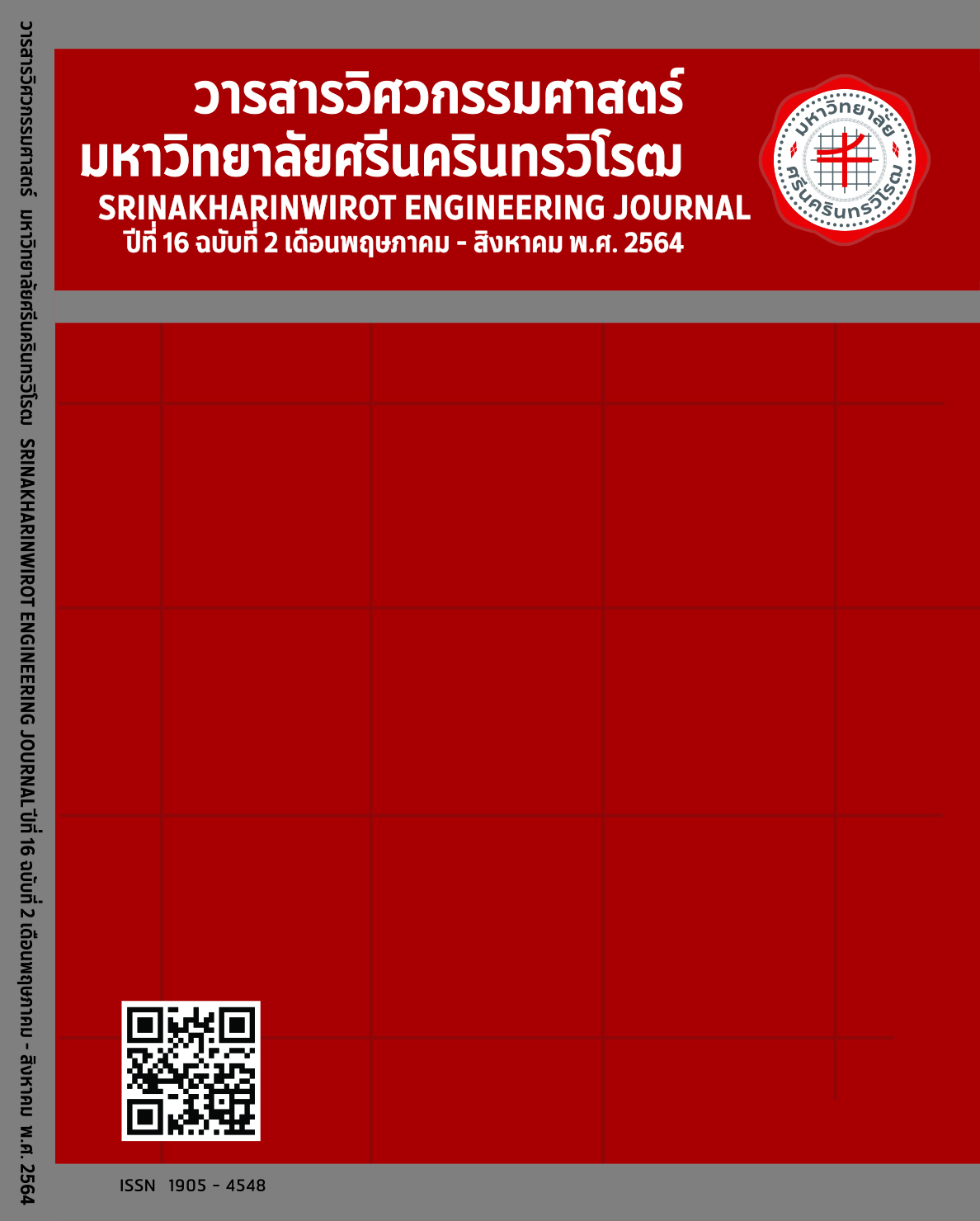กำลังอัด การดูดซึมน้ำ และการแทรกซึมคลอไรด์ของมอร์ต้าร์ในระบบวัสดุประสานสามชนิดด้วยกากแคลเซียมคาร์ไบด์และเถ้าลอย
Main Article Content
บทคัดย่อ
งานวิจัยนี้นำเสนอการพัฒนากากแคลเซียมคาร์ไบด์บด (GCCB) และเถ้าลอยบด (GFFA) เป็นวัสดุประสานผสมกับปูนซีเมนต์ปอร์ตแลนด์ชนิดที่ 1 (CT) ใช้ปูนซีเมนต์ปอร์ตแลนด์ชนิดที่ 1 แทนที่ด้วยเถ้าลอยบดในปริมาณร้อยละ 15 โดยน้ำหนักวัสดุประสาน นอกจากนั้น ในงานนี้ใช้กากแคลเซียมคาร์ไบด์บด เถ้าลอยบด และปูนซีเมนต์ปอร์ตแลนด์ชนิดที่ 1 ผสมรวมกันเป็นวัสดุประสานสามชนิดสำหรับผลิตมอร์ต้าร์ สำหรับระบบวัสดุประสานสามชนิดใช้ปูนซีเมนต์ปอร์ตแลนด์ชนิดที่ 1 แทนที่ด้วยเถ้าลอยบดในปริมาณร้อยละ 15 รวมกับกากแคลเซียมคาร์ไบด์บดในปริมาณร้อยละ 5, เถ้าลอยบดในปริมาณร้อยละ 15 รวมกับกากแคลเซียมคาร์ไบด์บด ในปริมาณร้อยละ 15 และใช้เถ้าลอยบดในปริมาณร้อยละ 15 รวมกับกากแคลเซียมคาร์ไบด์บดในปริมาณร้อยละ 25 โดยน้ำหนักวัสดุประสาน อัตราส่วนน้ำต่อวัสดุประสานใช้คงที่เท่ากับ 0.48 และใช้ค่าทดสอบการไหลแผ่ของมอร์ต้าร์เท่ากับร้อยละ 105-115 ด้วยสารลดน้ำพิเศษ ศึกษากำลังอัด การดูดซึมน้ำ และการแทรกซึมคลอไรด์ของมอร์ต้าร์ ผลการทดสอบพบว่า การใช้เถ้าลอยบดในปริมาณร้อยละ 15 โดยน้ำหนักวัสดุประสาน สามารถผลิตส่วนผสมมอร์ต้าร์ได้กำลังอัดที่ดี มอร์ต้าร์ปูนซีเมนต์ปอร์ตแลนด์ชนิดที่ 1 ที่แทนที่ด้วยเถ้าลอยบดในปริมาณร้อยละ 15 โดยน้ำหนักวัสดุประสาน มีค่ากำลังอัดอยู่ในช่วงร้อยละ 78-96 ของมอร์ต้าร์ที่ใช้ปูนซีเมนต์ปอร์ตแลนด์ชนิดที่ 1 อย่างไรก็ตาม การดูดซึมน้ำ และการแทรกซีมคลอไรด์ ของมอร์ต้าร์ที่แทนที่ด้วยเถ้าลอยบด ในปริมาณร้อยละ 15 รวมกับกากแคลเซียมคาร์ไบด์บดในปริมาณร้อยละ 5, เถ้าลอยบดในปริมาณร้อยละ 15 รวมกับกากแคลเซียมคาร์ไบด์บดในปริมาณร้อยละ 15 และใช้เถ้าลอยบดในปริมาณร้อยละ 15 รวมกับกากแคลเซียมคาร์ไบด์บดในปริมาณร้อยละ 25 โดยน้ำหนักวัสดุประสาน มีค่าสูงเมื่อเทียบกับมอร์ต้าร์ที่ใช้เถ้าลอยบดในปริมาณร้อยละ 15 โดยน้ำหนักวัสดุประสาน
Article Details

This work is licensed under a Creative Commons Attribution-NonCommercial-NoDerivatives 4.0 International License.
ลิขสิทธิ์เป็นของวารสารวิศวกรรมศาสตร์ มหาวิทยาลัยศรีนครินทรวิโรฒ
References
A. Sathonsaowapark, P. Chindaprasirt and K. Pimraksa, “Workability and strength of lignite bottom ash geopolymer mortar,” J. Harz. Mater., vol. 168, pp. 44-50, 2009.
P. Chindaprasirt, S. Rukzon and V. Sirivivatnanon, “Resistance to chloride penetration of blended Portland cement mortar containing palm oil fuel ash, rice husk ash and fly ash,” Constr. Build. Mater., vol. 22, no.5, pp. 932- 938, 2008.
P. Chindaprasirt and W. Chalee, “Effect of sodium hydroxide concentration on chloride penetration and steel corrosion of fly ash-based geopolymer concrete under marine site,” Constr. Build. Mater., vol. 63, pp. 303-310, 2014.
ASTM C230, “Standard Specification for Flow Table for use in Tests of Hydraulic Cement,” Annual Book of ASTM Standard., vol. 04.01, pp. 206- 211, 2005.
ASTM C109, “Standard Test Method for Compressive Strength of Hydraulic Cement Mortars (Using 2–in or [50 mm] Cube Specimens),” Annual Book of ASTM Standards., Vol. 04.01, pp. 76- 81, 2005.
ASTM C642, “Standard Test Method for Density, Absorption, and Voids in Hardened Concrete,” Annual Book of ASTM Standards., vol. 04.02, pp. 338-340, 2005.
ASTM C39, “Standard Test Method for Compressive Strength of Cylindrical Concrete Specimens,” Annual Book of ASTM Standards., vol. 04.02, 21-27, 2005.
P. Krammart amd S. Tangtermsirikul, “Properties of cement made by parlially replacing cement law materials with municipal solid waste ashes and calcium carbide waste,” Constr. Build. Mater., vol. 18, pp. 579-583, 2004.
N. Makaratat, C. Jaturapitakkul and T. Laosamathikul, “Effects of Calcium Carbide Residue–Fly Ash Binder on Mechanical Properties of Concrete,” J. Mater. Civil Eng., vol. 22, no. 11, pp. 1164-1170, 2010.
ASTM C618. “Standard Specification for Coal Fly Ash and Raw or Calcined Natural Pozzolan for Use as a Mineral Admixture in Concrete,” Annual Book of ASTM Standard., vol. 04.02, pp. 323-325, 2005.
K. Somna, C. Jaturapitakkul and P. Kajitvichyanukul, “Microstructure of Calcium Carbide Residue–Ground fine fly ash Paste,” J. Mater. Civil Eng., vol. 23, no. 3, pp. 298-304, 2010.
A.M. Neville, “Properties of concrete,” 4th and Final Edition, Malaysia: Longman Group Limited, 1995.
S. Rukzon and P. Chindaprasirt, “Strength, Chloride Penetration and Corrosion Resistance of Ternary Blends of Portland Cement Self-compacting Concrete Containing Bagasse Ash and Rice Husk-bark Ash,” Chiang Mai J. Sci., vol. 45, no. 4, pp. 863-1874, 2018.
ASTM C1202, “Standard Test Method for Electrical Indication of Concrete’s Ability to Resist Chloride Ion Penetration,” Annual Book of ASTM Standard., vol. 04.02, pp. 646-651, 2001.

